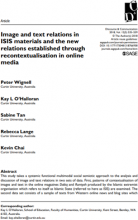This study takes a systemic functional multimodal social semiotic approach to the analysis and discussion of image and text relations in two sets of data. First, patterns of contextualisation of images and text in the online magazines Dabiq and Rumiyah produced by the Islamic extremist organisation which refers to itself as Islamic State (referred to here as ISIS) are examined. The second data set consists of a sample of texts from Western online news and blog sites which include recontextualisations of images found in the first data set. A sample of examples of the use and re-use of images is discussed in order to identify patterns of similarity and difference when images and text are recontextualised. It is argued that the ISIS material tends to foreground the interpersonal metafunction in combination with the textual metafunction (i.e. the stance towards the content and the organisation of the message for this purpose), while the other data set tends to foreground the ideational metafunction (the participants, processes and circumstances of what is being reported). These inferences indicate that further exploration of a larger data set is worth pursuing. Such studies would provide deeper insights helping to distinguish between online material which supports terrorism and that which opposes it, as well as facilitating the further development of multimodal social semiotic approaches to image and text relations.
